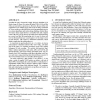Free Online Productivity Tools
i2Speak
i2Symbol
i2OCR
iTex2Img
iWeb2Print
iWeb2Shot
i2Type
iPdf2Split
iPdf2Merge
i2Bopomofo
i2Arabic
i2Style
i2Image
i2PDF
iLatex2Rtf
Sci2ools
WWW
2003
ACM
2003
ACM
Efficient URL caching for world wide web crawling
Crawling the web is deceptively simple: the basic algorithm is (a) Fetch a page (b) Parse it to extract all linked URLs (c) For all the URLs not seen before, repeat (a)?(c). However, the size of the web (estimated at over 4 billion pages) and its rate of change (estimated at 7% per week) move this plan from a trivial programming exercise to a serious algorithmic and system design challenge. Indeed, these two factors alone imply that for a reasonably fresh and complete crawl of the web, step (a) must be executed about a thousand times per second, and thus the membership test (c) must be done well over ten thousand times per second against a set too large to store in main memory. This requires a distributed architecture, which further complicates the membership test. A crucial way to speed up the test is to cache, that is, to store in main memory a (dynamic) subset of the "seen" URLs. The main goal of this paper is to carefully investigate several URL caching techniques for we...
| Added | 22 Nov 2009 |
| Updated | 22 Nov 2009 |
| Type | Conference |
| Year | 2003 |
| Where | WWW |
| Authors | Andrei Z. Broder, Marc Najork, Janet L. Wiener |
Comments (0)

